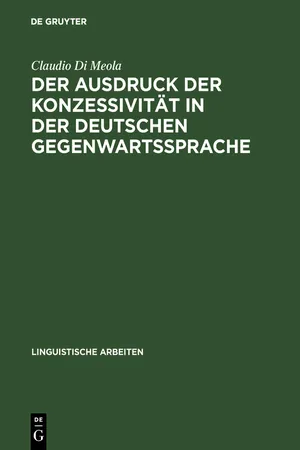
- 348 pages
- English
- PDF
- Available on iOS & Android
Der Ausdruck der Konzessivität in der deutschen Gegenwartssprache
About this book
In diesem Buch werden die bisher wenig erforschten Konzessivkonstruktionen der deutschen Gegenwartssprache untersucht und anhand einer Gegenüberstellung mit dem Italienischen näher beleuchtet. Als Materialgrundlage dient ein reichhaltiges Korpus von über 5000 deutschen Beispielen, die Texten der neunziger Jahre (aus den Bereichen Presse-, Fach- und Literatursprache) entnommen sind. Zunächst wird der Begriff der Konzessivität näher bestimmt und als 'versteckte Kausalität' definiert. Darauf aufbauend wird eine Typologie der verschiedenen konzessiven Werte ausgearbeitet. Es folgt ein Überblick über die wichtigsten Konnektive im Deutschen: subordinierende wie z.B. obwohl, obgleich und auch wenn, koordinierende wie dennoch oder trotzdem, präpositionale wie trotz. Die Darstellung ist jeweils nach morphologisch-etymologischen Gruppen geordnet, wobei überdies zwischen expliziten, eindeutig konzessiven und impliziten, gelegentlich konzessiven Konnektiven unterschieden wird. Anschließend werden relevante Aspekte der subordinierenden Konstruktionen vertieft (u.a. textsortenspezifische Frequenz, Vollständigkeit und Stellung des Nebensatzes, Wortstellungsfragen und konzessive Semantik). Nach einer detaillierten Analyse des Italienischen - dessen Korpus in Umfang und Ausdifferenzierung dem deutschen entspricht - wird ersichtlich, daß in beiden Sprachen die morphologische Struktur eines Konnektivs entscheidenden Einfluß hat auf die semantischen und syntaktischen Eigenschaften der jeweiligen Gesamtkonstruktion: Mit einer progressiven formalen Integration des Konnektivs nimmt gleichfalls seine Entsemantisierung zu; höhergradig grammatikalisierte Konnektive treten zudem bevorzugt in Satzgefügen auf, die syntaktisch eng verbunden sind.
Frequently asked questions
- Essential is ideal for learners and professionals who enjoy exploring a wide range of subjects. Access the Essential Library with 800,000+ trusted titles and best-sellers across business, personal growth, and the humanities. Includes unlimited reading time and Standard Read Aloud voice.
- Complete: Perfect for advanced learners and researchers needing full, unrestricted access. Unlock 1.4M+ books across hundreds of subjects, including academic and specialized titles. The Complete Plan also includes advanced features like Premium Read Aloud and Research Assistant.
Please note we cannot support devices running on iOS 13 and Android 7 or earlier. Learn more about using the app.
Information
Table of contents
- Inhalt
- Vorwort
- Einleitung
- 1. Forschungsstand
- 2. Definition der Konzessivität
- 3. Klassifikation der wichtigsten konzessiven Werte
- 4. Überblick über die konzessiven Konstruktionen im Deutschen
- §. Prototypische und periphere Konzessivkonstruktionen
- 6. Analyse der wichtigsten subordinierten Konstruktionen im Deutschen
- 7. Überblick über die konzessiven Konstruktionen im Italienischen
- 8. Analyse der wichtigsten subordinierten Konstruktionen im Italienischen
- 9. Eine kurze deutsch-italienische Gegenüberstellung: Gemeinsamkeiten und Unterschiede
- 10. Schlußbemerkung
- Anhang
- Literatur